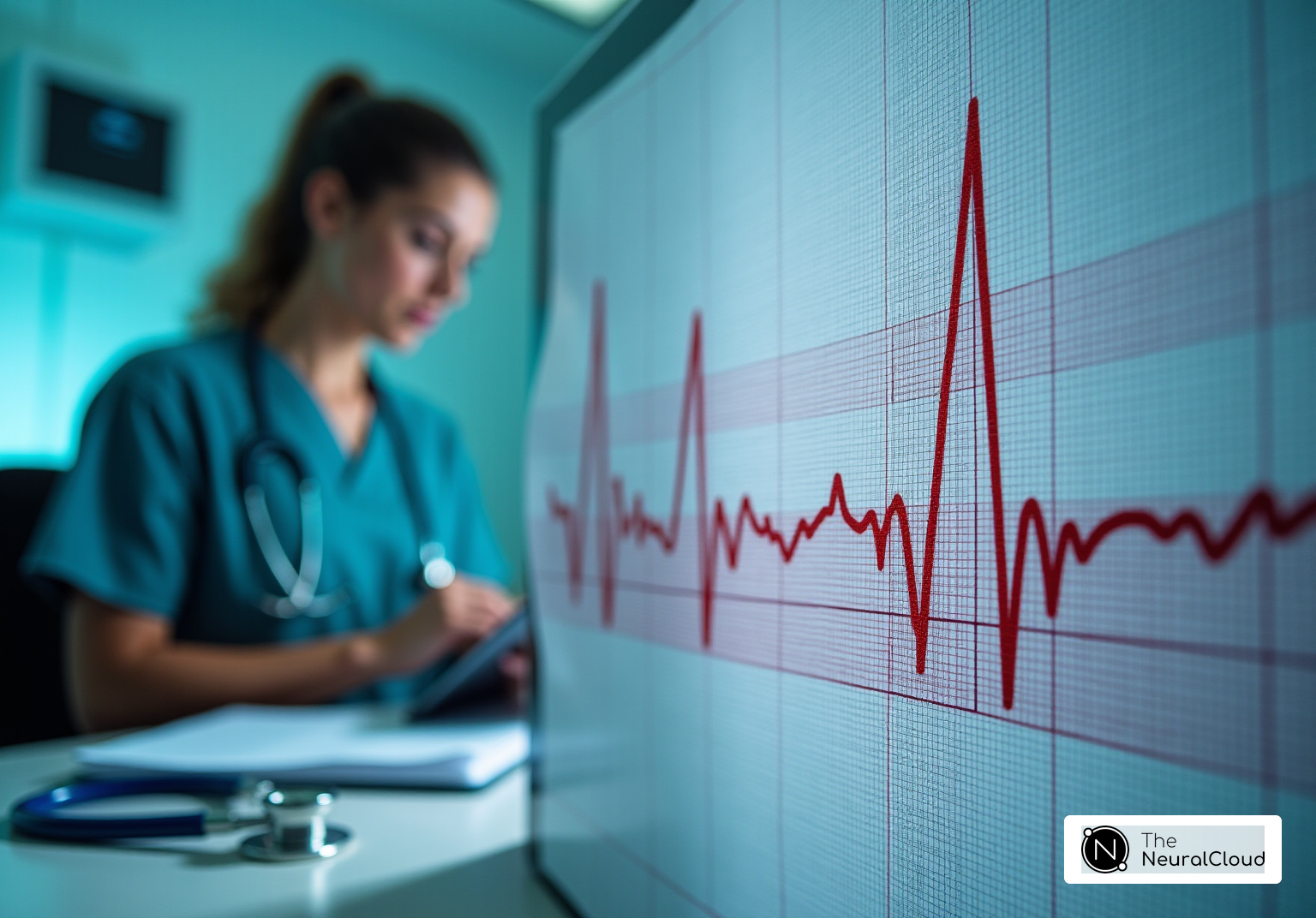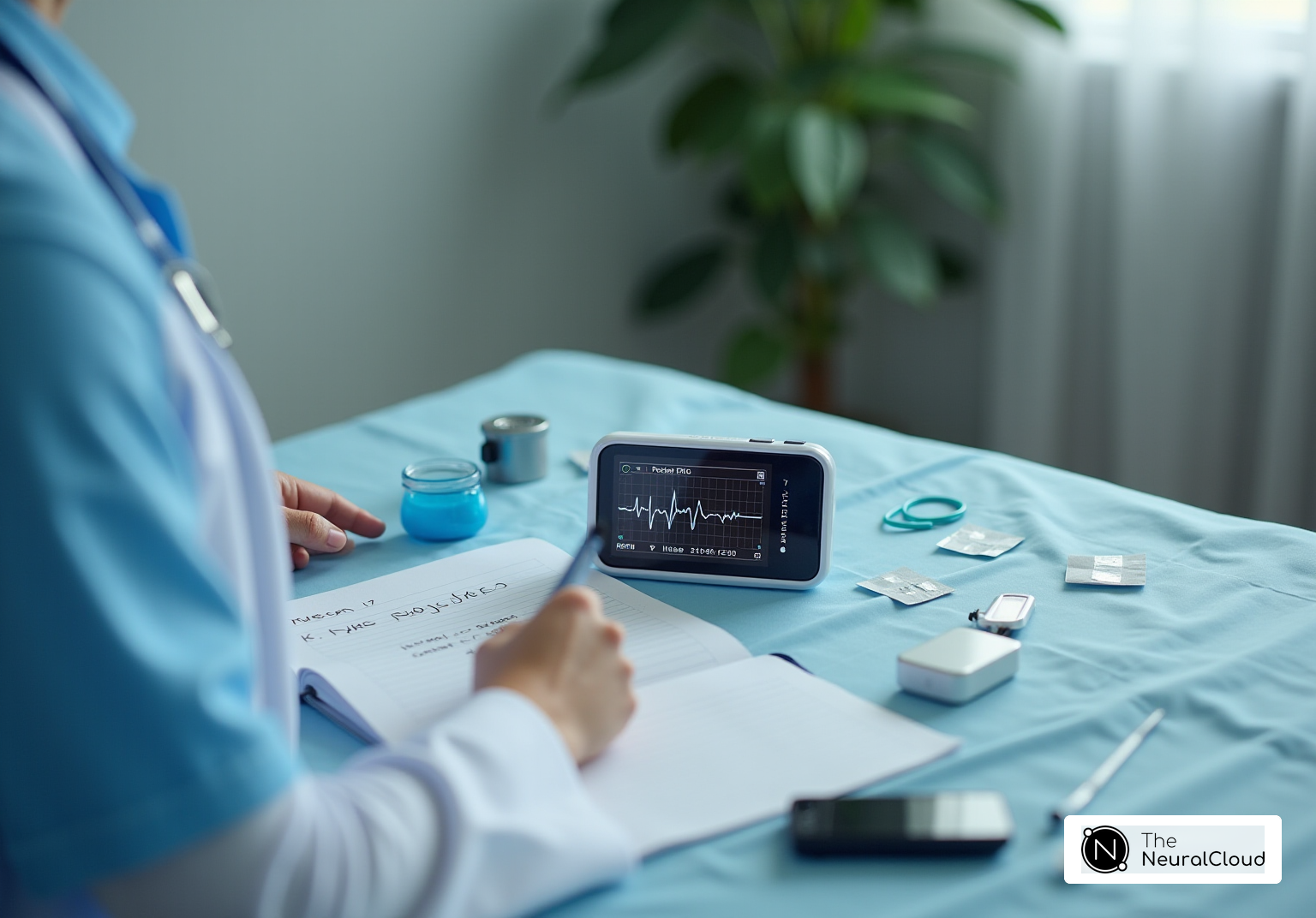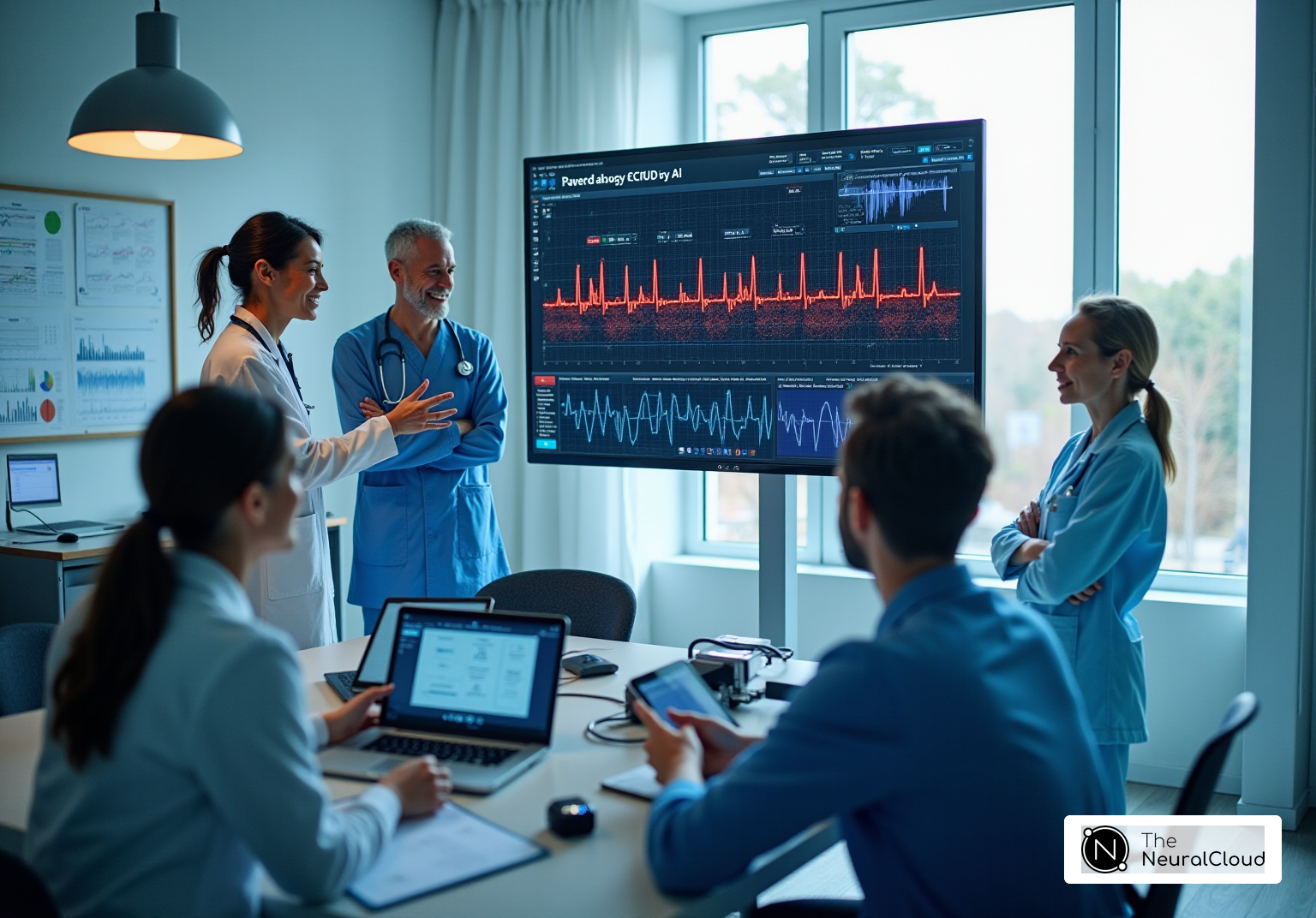Overview
The article presents a comprehensive overview of the challenges faced in ECG analysis, highlighting the critical need for accurate heart rate calculations. Understanding the components of an ECG is essential for healthcare professionals, as it lays the foundation for effective diagnosis and treatment. To address these challenges, the article introduces various calculation methods tailored to different clinical scenarios, ensuring that practitioners can select the most appropriate approach for their needs.
One of the standout solutions discussed is Neural Cloud Solutions' MaxYield™ platform. This advanced tool enhances the accuracy and efficiency of heart rate analysis, even in challenging conditions. The platform features cutting-edge algorithms and user-friendly interfaces that streamline ECG interpretation, making it easier for healthcare professionals to obtain reliable results quickly.
The advantages of using MaxYield™ are significant. By improving ECG analysis, the platform not only saves time but also reduces the likelihood of errors in heart rate calculations. This means that healthcare professionals can focus more on patient care rather than getting bogged down by complex data interpretation. Additionally, the platform's ability to adapt to various clinical scenarios ensures that practitioners have the flexibility they need in their workflows.
In summary, the MaxYield™ platform represents a valuable asset for healthcare professionals engaged in ECG analysis. Its features, including advanced algorithms and a user-friendly interface, provide clear benefits that enhance diagnostic accuracy and efficiency. By incorporating such innovative tools, practitioners can significantly improve their approach to heart rate calculation, ultimately benefiting patient outcomes.
Introduction
Understanding the intricacies of heart rate calculation from an ECG can seem daunting; however, it is a vital skill for healthcare professionals. This article explores effective methods and step-by-step techniques for accurately calculating heart rate from ECG readings, addressing common challenges that may arise during the process. With the right knowledge and tools, mastering this essential aspect of cardiac care is achievable. How can one ensure precision in a field where even minor errors can lead to significant consequences?
Understand ECG Basics and Heart Rate Fundamentals
To effectively determine how to calculate heart rate from ECG, it is essential to understand the fundamental components of an ECG waveform. The ECG consists of several key characteristics:
- The P component
- QRS complex
- T component
Within the QRS complex, the R signal is particularly critical for pulse calculations.
Neural Cloud Solutions' MaxYield™ addresses the challenges of ECG analysis, even in recordings with significant noise and artifacts. This platform enables efficient analysis, allowing for the swift identification of ECG signals and the recovery of previously obscured sections of lengthy recordings. The pulse, typically expressed in beats per minute (bpm), can be derived from the frequency of these R signals, which illustrates how to calculate heart rate from ECG. A standard resting pulse ranges from 60 to 100 bpm.
Understanding how to calculate heart rate from ECG involves familiarity with the standard paper speed of 25 mm/sec, which corresponds to 5 large squares per second, and is crucial for accurate calculations. By leveraging MaxYield™'s advanced noise filtering and signal recognition capabilities, health tech developers can tackle inefficiencies and physiological variability, leading to more precise pulse measurements.
Furthermore, the algorithm continuously evolves with each use, enhancing its accuracy and efficiency over time. This ongoing improvement ensures that healthcare professionals can rely on MaxYield™ for consistent and reliable ECG analysis.

Explore Methods for Calculating Heart Rate from ECG
Understanding how to calculate heart rate from ECG presents various challenges, but several methods exist to address these, particularly when enhanced by Neural Cloud Solutions' MaxYield™ platform. Each method is tailored to specific clinical scenarios, ensuring accurate and efficient pulse estimations, such as how to calculate heart rate from ECG.
-
Six-Second Method: This technique involves counting the number of R peaks in a 6-second strip and multiplying by 10. It is especially effective for irregular rhythms, allowing for rapid assessment in dynamic clinical situations. With MaxYield™, automated labeling reduces the time spent on manual computations, ensuring prompt interventions based on precise pulse estimations.
-
Large Block Method: By counting the number of large squares between two consecutive R peaks and dividing 300 by this number, clinicians can quickly ascertain the pulse. This method is ideal for regular rhythms, and MaxYield™ streamlines this process, minimizing operational costs while enhancing workflow efficiency.
-
Small Block Method: This technique requires counting the number of small squares between two R waves and dividing 1500 by this number. It provides an exact pulse measurement, making it particularly beneficial in comprehensive ECG evaluations where precision is crucial. MaxYield™ enhances this method by providing automated annotations that improve reliability and reduce the impact of signal artifacts.
-
QRS Complex Count: In this approach, the quantity of QRS complexes in a 10-second strip is counted and multiplied by 6 to determine the pulse per minute. This straightforward method is commonly employed in clinical settings, and with the support of MaxYield™, it can be executed more efficiently, addressing challenges like physiological variability and ensuring consistent results.
The Six-Second Method is especially acknowledged for its speed and effectiveness in managing irregular rhythms, which is useful for those learning how to calculate heart rate from ECG, as emphasized by healthcare professionals in real-world applications. For instance, in cases of atrial fibrillation, where the rhythm is frequently erratic, this approach facilitates prompt interventions based on precise pulse estimations.
When comparing the accuracy of these methods, the Large Block Method is favored for regular rhythms, while the Small Block Method is preferred for fast rhythms due to its precision. Ultimately, the choice of method for how to calculate heart rate from ECG may vary among clinicians, reflecting their individual preferences and the specific clinical context.
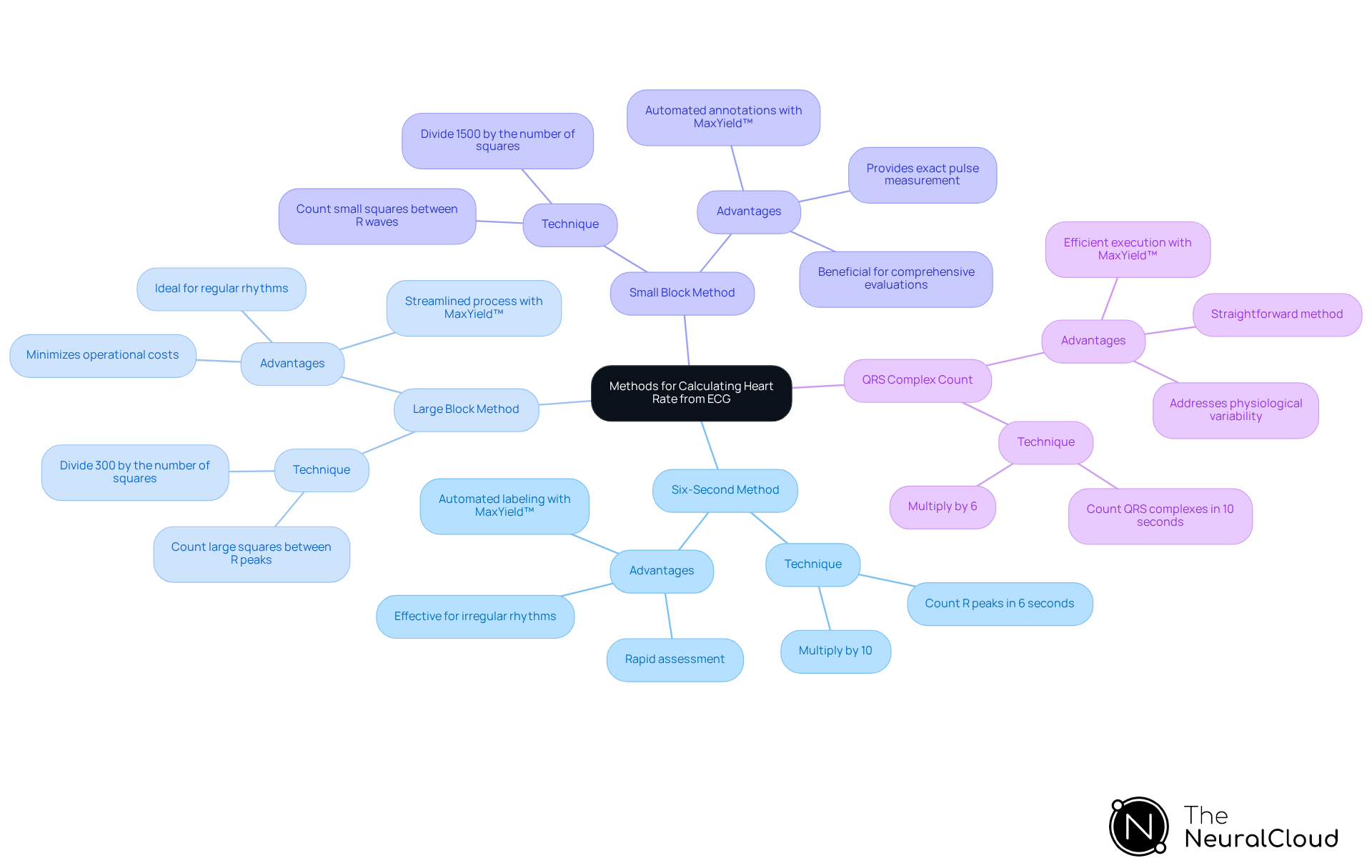
Apply Step-by-Step Techniques for Accurate Heart Rate Calculation
To calculate heart rate accurately from ECG tracings, follow these essential steps:
-
Select the ECG Strip: Choose a clear ECG strip that displays a consistent rhythm. Ensure the paper speed is set at 25 mm/sec for accurate measurements.
-
Identify R Peaks: Locate the R peaks on the ECG, which are the tops of the QRS complexes. Precise recognition of these signals is essential, as top cardiologists stress that misidentifying R signals can lead to considerable mistakes in how to calculate heart rate from ECG. As cardiologist Amit Lehavi observes, "Heart rhythm variability (HRV) reflects cardiac and autonomic nervous system activity," emphasizing the significance of accurate measurements. Utilizing Neural Cloud Solutions' MaxYield™ platform enhances this process by effectively filtering noise and recognizing signal patterns, ensuring that R waves are accurately identified even in challenging recordings, including those affected by baseline wander and muscle artifacts.
-
Choose a Calculation Method: Depending on the rhythm:
- For regular rhythms, utilize either the Large Block Method or the Small Block Method.
- For irregular rhythms, the Six-Second Method is recommended.
-
Perform the Calculation:
- Large Block Method: Count the large squares between two R waves and divide 300 by this number to find the heart rate in beats per minute (bpm).
- Small Block Method: Count the small squares between two R peaks and divide 1500 by this number. For instance, if there are 15 small squares, this demonstrates how to calculate heart rate from ECG as 1500 / 15 = 100 bpm.
- Six-Second Method: Count the R peaks in a 6-second strip and multiply by 10 to determine the bpm.
-
Record the Pulse: Document the calculated pulse in bpm for future reference. This practice aids in clinical decision-making and enhances the accuracy of patient assessments. The integration of MaxYield™ can further streamline this process by automating labeling and reducing costs associated with ECG analysis.
Frequent mistakes in pulse calculations often arise from miscounting squares or inaccurately recognizing R peaks, which can happen in as many as 20% of instances. By adhering to these best practices and utilizing the advanced capabilities of Neural Cloud Solutions' MaxYield™, healthcare professionals can significantly improve the reliability of their ECG analyses.

Troubleshoot Common Issues in ECG Heart Rate Calculation
When calculating heart rate from an ECG, several common issues may arise that can affect accuracy:
-
Poor Signal Quality: Unclear ECG strips can significantly hinder analysis. Proper electrode placement and good skin contact are essential to minimize noise. If quality remains low, re-recording may be necessary. Studies indicate that ECG signal quality can fluctuate, with daytime recordings often exhibiting lower quality due to motion artifacts. Neural Cloud Solutions' MaxYield™ platform addresses these challenges by employing advanced noise filtering and distinct wave recognition. This allows for the isolation of ECG waves even in recordings with high levels of noise and artifact, salvaging previously obscured sections of lengthy Holter, 1-Lead, and patch monitor recordings, thereby enhancing overall analysis efficiency. The MaxYield™ algorithm evolves with each use, continuously improving its accuracy and efficiency, which is vital in overcoming the challenges posed by artifacts.
-
Irregular Rhythms: To manage irregular rhythms of the heart, it's important to understand how to calculate heart rate from ECG. The Six-Second Method is especially effective for these situations, enabling a rapid evaluation of variability in pulse.
-
Counting Errors: Miscounting R peaks or squares is a frequent mistake, particularly in rapid rhythms. It’s essential to verify counts to guarantee precision, as even small mistakes can result in considerable differences in pulse calculations.
-
Paper Speed Confusion: Be mindful of the paper speed setting on the ECG machine. The standard speed is 25 mm/sec; if the speed differs, adjust your calculations accordingly to maintain accuracy.
-
Artifact Interference: Artifacts can occasionally resemble R signals, complicating the counting process. Focus on identifying clear R waves amidst any noise to learn how to calculate heart rate from ECG accurately.
Healthcare technicians often highlight the challenges posed by poor signal quality, noting that it can lead to misinterpretations and delays in diagnosis. A study found that nearly 10% of abnormal rhythms were incorrectly classified as normal due to signal quality issues. Additionally, 13.2% of computer-based rhythm statements required physician revision, emphasizing the necessity of human oversight in ECG interpretation. Addressing these challenges through proper electrode application and awareness of environmental factors can significantly enhance ECG analysis outcomes. Continuous education on ECG interpretation is also crucial, as noted by experts in the field.
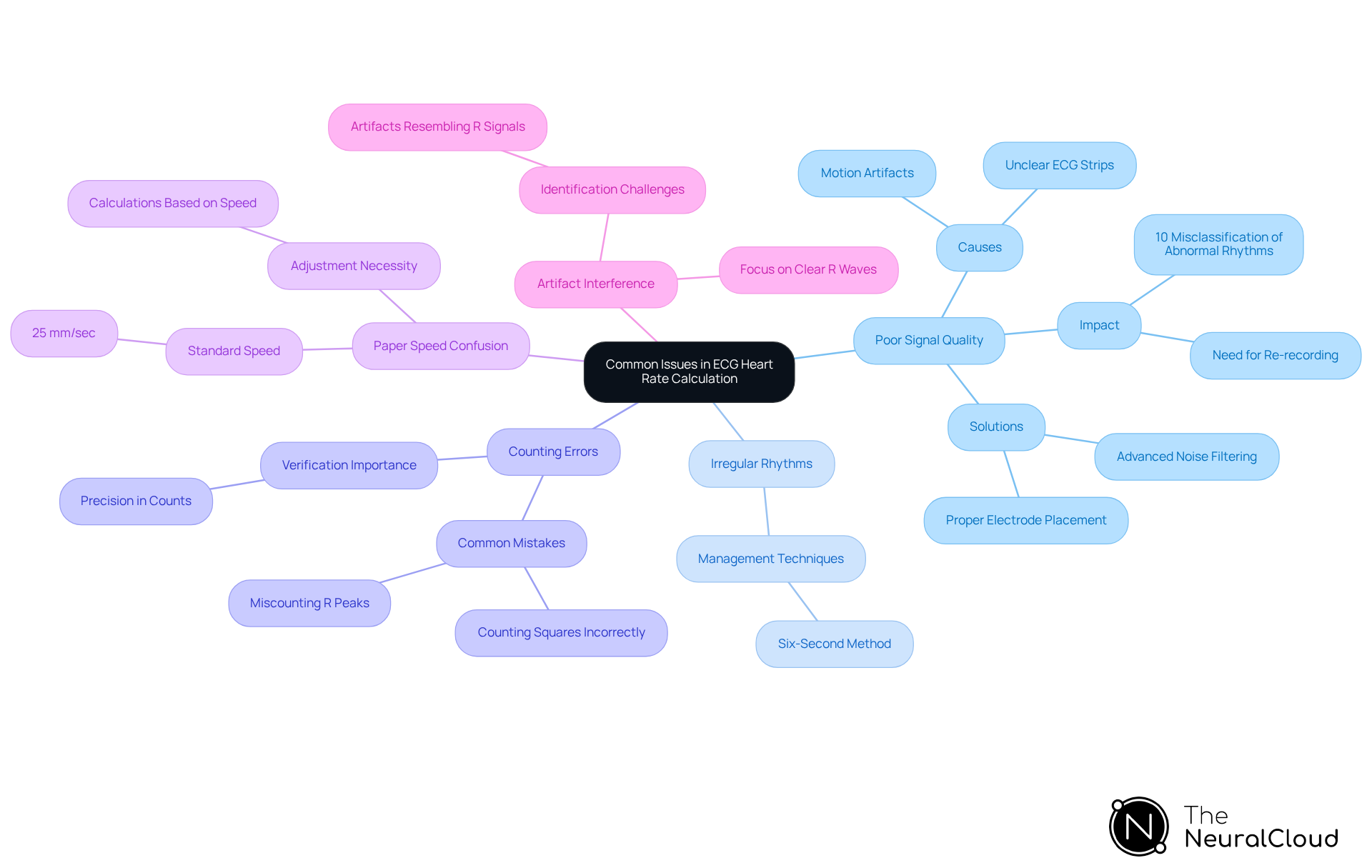
Conclusion
Mastering the calculation of heart rate from ECG is a vital skill that enhances the accuracy of cardiac assessments and patient care. The process involves understanding the fundamental components of an ECG waveform, particularly the significance of the R peaks within the QRS complex. By leveraging effective methods such as the Six-Second Method, Large Block Method, and Small Block Method, healthcare professionals can derive precise heart rate measurements tailored to various clinical scenarios.
Throughout the article, essential techniques and tools have been discussed to ensure accurate heart rate calculations. The integration of Neural Cloud Solutions' MaxYield™ platform is highlighted for its ability to tackle challenges such as noise and irregular rhythms. This platform enhances ECG analyses by improving reliability, which is crucial for accurate diagnostics. Additionally, addressing common issues like poor signal quality and counting errors is essential for maintaining accuracy in pulse measurements.
As the ability to calculate heart rate from ECG is paramount in clinical practice, it is essential for healthcare professionals to continuously refine their skills and utilize advanced technologies. By fostering a deeper understanding of ECG fundamentals and employing systematic approaches, clinicians can enhance diagnostic precision and provide better patient outcomes. Embracing these techniques not only contributes to individual proficiency but also elevates the standards of cardiac care across the healthcare landscape.
Frequently Asked Questions
What are the key components of an ECG waveform?
The key components of an ECG waveform are the P component, the QRS complex, and the T component. The R signal within the QRS complex is particularly important for pulse calculations.
How is heart rate calculated from an ECG?
Heart rate is calculated from an ECG by deriving the pulse from the frequency of R signals in the QRS complex. The pulse is typically expressed in beats per minute (bpm).
What is the standard resting pulse rate?
A standard resting pulse rate ranges from 60 to 100 bpm.
Why is the standard paper speed of 25 mm/sec important for ECG analysis?
The standard paper speed of 25 mm/sec, which corresponds to 5 large squares per second, is crucial for accurate calculations of heart rate from the ECG.
How does Neural Cloud Solutions' MaxYield™ improve ECG analysis?
MaxYield™ addresses challenges in ECG analysis by providing advanced noise filtering and signal recognition capabilities, enabling efficient analysis even in recordings with significant noise and artifacts.
How does the MaxYield™ algorithm enhance its performance?
The MaxYield™ algorithm continuously evolves with each use, improving its accuracy and efficiency over time, which helps healthcare professionals rely on it for consistent ECG analysis.
